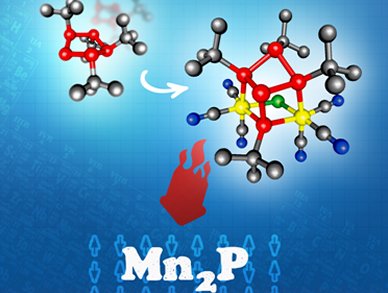Transition-metal complexes could be suitable precursors for binary metal phosphides, which have a wide range of applications such as corrosion resistors, catalysts for hydrodesulfurization and hydrodenitrogenation, oxygen barriers, semiconductors, magnetic materials, anode materials in lithium ion batteries, and nanoparticles.
Evamarie Hey-Hawkins and her team, Leipzig University, Germany, have disclosed a novel dinuclear Mn(I) complex containing the oligophosphanide ligand in the rearranged form [{cyclo-(P5tBu4)}PtBu]–. The new binding mode for the anion was observed when Na[cyclo-(P5tBu4)] reacted with two equivalents of [MnBr(CO)5] to give the phosphorus-rich manganese(I) complex [Mn2(μ-Br){cyclo-(P4tBu3)PtBu}(CO)6] (pictured).

The mechanism of this rearrangement was studied theoretically and the thermolysis of the new compound was performed and studied by thermogravimetry/differential thermal analysis and powder X-ray diffraction analysis, to finally give the metal phosphide Mn2P as the final product.
Image: © Wiley-VCH
- Synthesis and Thermolysis of the Phosphorus-Rich Manganese(I) Complex [Mn2(μ-Br){cyclo-(P4tBu3)PtBu}(CO)6]: From Complexes to Metal Phosphides,
A. Kircali, R. Frank, S. Gómez-Ruiz, B. Kirchner, E. Hey-Hawkins,
ChemPlusChem 2012.
DOI: 10.1002/cplu.201200013
This article is available for free as part of the ChemPlusChem free trial.



